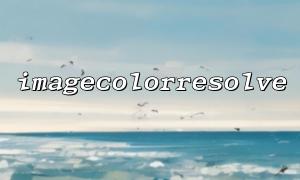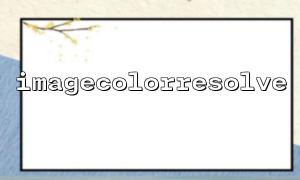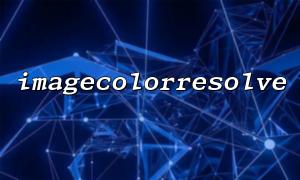When processing images using PHP's GD library, imagecolorresolve() and imagecolorallocate() are two frequently encountered functions. Although they are all related to color, their actual uses and effects vary. Understanding the difference between them will help us choose more appropriate methods during the development process and improve the efficiency and quality of image processing.
imagecolorallocate() is used to assign a new color on an image. Simply put, it is to add a color to the palette of the image and return the identifier of the color.
If the image is palette-based (such as 8-bit PNG or GIF), each time a new color is assigned, a record is added to the internal palette until the palette maximum capacity is reached (usually 256 colors). If the palette is full, imagecolorallocate() will fail, returning false .
Sample code:
<?php
$image = imagecreate(100, 100); // Create a 100x100 Blank pictures
$red = imagecolorallocate($image, 255, 0, 0); // Assign a red
imagefill($image, 0, 0, $red); // Fill the background with red
imagepng($image, 'https://m66.net/upload/red.png');
imagedestroy($image);
?>
In the above code, we explicitly tell PHP that we need a brand new red that will be assigned to the palette and return the corresponding color ID.
imagecolorresolve() is used to find an existing color closest to the given RGB value . If it exists, it returns the existing color ID. If there is no close, and there is room for the palette, it will assign a new color.
That is, it prioritizes the use of existing colors, avoiding unnecessary addition of new colors, so that it can use limited palette resources more efficiently.
Sample code:
<?php
$image = imagecreate(100, 100); // Create a 100x100 Blank pictures
$red = imagecolorresolve($image, 254, 1, 1); // Find a color close to red
imagefill($image, 0, 0, $red); // Fill the background with the found colors
imagepng($image, 'https://m66.net/upload/resolved_red.png');
imagedestroy($image);
?>
Note that imagecolorresolve() requires close to the specified color, not precise allocation.
Choosing imagecolorallocate() or imagecolorresolve() depends on your needs:
If you need a sure and accurate color that can tolerate color palette growth, choose imagecolorallocate() .
If you want to save on palette resources and reuse existing colors as much as possible, select imagecolorresolve() .
Generally speaking, if you know that the number of colors in an image will not be too large, you can use imagecolorallocate() directly. If the image is rich in color, or you are working on images that have limits on the number of colors like GIFs, it is recommended to use imagecolorresolve() first.
| Functional Points | imagecolorallocate() | imagecolorresolve() |
|---|---|---|
| Purpose | Assign a new color | Use existing close colors and assign them if necessary |
| Palette pressure | Large (may cause overflow) | Small (reusable as much as possible) |
| Use scenarios | Precise color control scenes | Scenes that save color resources |
In actual development, mastering the difference between these two functions can make your image processing program both efficient and stable!














